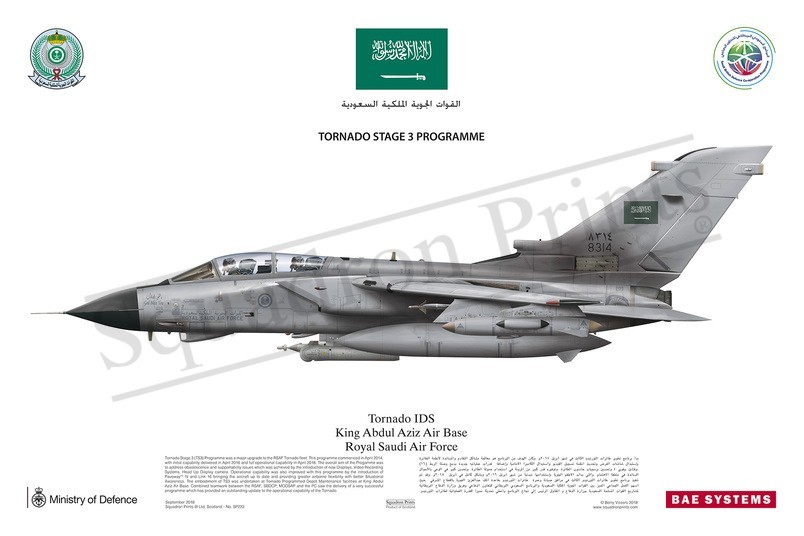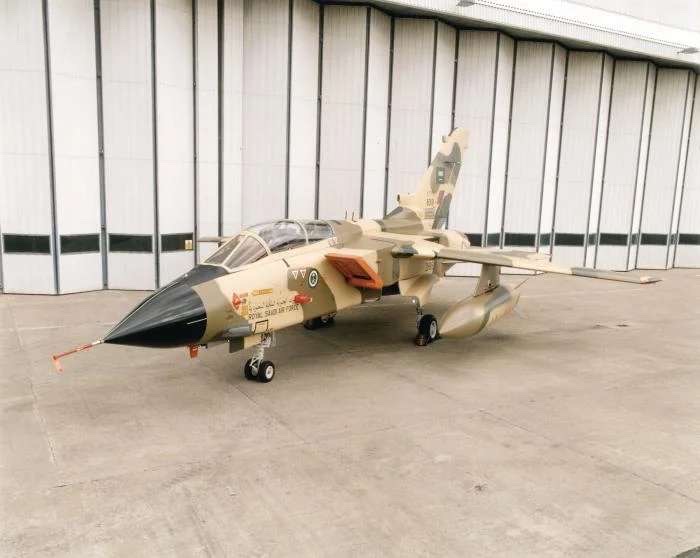- Yes
- No
- Premium
- Tree variant
- Event
- I said no
War Thunder Aircraft Suggestion: Panavia Tornado IDS (Royal Saudi Air Force)

Introduction
The Panavia Tornado IDS (Interdictor/Strike) has been a cornerstone of the Royal Saudi Air Force (RSAF) since its induction in the late 1980s. Renowned for its versatility in low-level penetration and precision strike capabilities, the Tornado IDS has significantly bolstered Saudi Arabia’s aerial combat and strike operations. This proposal aims to highlight the RSAF’s Tornado IDS, emphasizing its unique features and operational history, making it a compelling addition to War Thunder’s lineup.
History
History
Acquisition and Entry into Service
As part of the Al-Yamamah arms deal between the United Kingdom and Saudi Arabia, the RSAF acquired 48 Tornado IDS aircraft. The first of these jets was delivered on March 26, 1986, to King Abdulaziz Air Base in Dhahran. By October 1987, No. 7 Squadron had received 20 aircraft, marking the full integration of the Tornado IDS into the RSAF’s operational fleet.
Operational Service
• 1991 Gulf War: During Operation Desert Storm, RSAF Tornado IDS aircraft played a pivotal role in strike missions against strategic targets. Notably, on the night of January 19/20, 1991, an RSAF Tornado (serial number 765) was lost during a mission, underscoring the high-risk operations undertaken by these crews.
• Yemen Conflict: In November 2009, RSAF Tornados were deployed in air raids during the Shia insurgency in northern Yemen. This marked the first combat operation for the RSAF since the Gulf War. The Tornado IDS fleet continued to be instrumental in subsequent operations, including the Saudi-led intervention in Yemen.
Modernization and Upgrades
In 2006, Saudi Arabia initiated a £2.5 billion contract with BAE Systems to upgrade up to 80 Tornado IDS aircraft under the Tornado Sustainment Programme (TSP). These upgrades aimed to extend the operational life of the fleet until at least 2020, incorporating advanced precision-guided munitions and enhanced targeting systems.
General Information
• Type: Multirole Attack Aircraft
• Country: Saudi Arabia
• Crew: 2 (Pilot and Weapons Systems Officer)
• First Year of Service: 1986
• Engine: 2× RB.199-34R Mk.103 afterburning turbofans
• Max Speed: 920 knots (Mach 1.6 at altitude)
• Wingspan: 13.9 m
• Length: 16.7 m
• Height: 5.95 m
• Max Takeoff Weight: 28,000 kg
• Armament: Diverse array of air-to-ground and air-to-air munitions, including precision-guided bombs, anti-ship missiles, and internal 27mm Mauser BK-27 cannons.
Key Features
- Avionics and Sensors:
Tornado Nose Radar (TNR): Equipped with Terrain-Following Radar (TFR) and Ground Mapping Radar (GMR) modes, facilitating low-level navigation and target acquisition.
• ARI.18241/2 Radar Warning Receiver (RWR): Provides enhanced situational awareness against radar threats with a detection range of up to 222.2 km.
Weapons and Loadouts
The Royal Saudi Air Force’s Panavia Tornado IDS is equipped with a versatile array of weapons and support systems, enabling it to perform a wide range of missions. Below is an organized list of its primary armament and equipment:
Air-to-Ground Munitions:
• Paveway IV (Mk82): A dual-mode GPS/laser-guided bomb designed for precision strikes against ground targets.
• Brimstone Missile: A radar-guided anti-armor missile effective against both static and moving targets.
• Storm Shadow: A long-range, air-launched cruise missile designed for strategic strikes against high-value targets.
• ALARM (Air-Launched Anti-Radiation Missile): Designed to suppress enemy air defenses by targeting radar installations.
• JP233 Anti-Runway Dispenser: A specialized weapon system carrying runway penetrators and area denial submunitions to disable enemy airfields.
• Mk13 1,000 lb General Purpose Bomb: A conventional unguided bomb used for a variety of ground targets.
Air-to-Air Missiles:
• AIM-2000A IRIS-T: A highly agile, infrared-guided short-range missile for dogfighting and close-quarters aerial engagements.
Electronic Warfare and Countermeasures:
• ARI.23246 Sky Shadow ECM Pod: An electronic countermeasure pod designed to jam enemy radar systems, enhancing aircraft survivability.
• BOZ-107 Chaff/Flare Dispenser Pod: Provides chaff and flare deployment to counter radar-guided and infrared-seeking missiles.
Support and Auxiliary Equipment:
• Damocles Laser Designation Pod (LDP): Equipped with Forward-Looking Infrared (FLIR) and Laser Rangefinder and Marked Target Seeker (LRMTS) for target acquisition and guidance.
• 550 Imperial Gallon Drop Tank: External fuel tank used to extend the aircraft’s operational range for long-distance missions.
-
Flight Characteristics:
• Variable-Sweep Wings: Allows optimization for both high-speed dashes and low-speed maneuverability, enhancing mission versatility.• RB.199-34R Mk.103 Engines: Deliver high thrust-to-weight ratio, ensuring excellent acceleration and climb performance.

Proposed Role in War Thunder
In War Thunder, the RSAF’s Tornado IDS would serve as a formidable multirole aircraft, excelling in both ground-attack and limited air-to-air engagements. Its advanced avionics, diverse weaponry, and variable-sweep wing design would offer players a versatile platform capable of performing precision strikes, anti-ship missions, and self-defense against aerial threats.
























